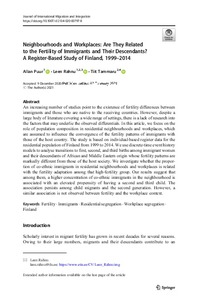Neighbourhoods and Workplaces: Are They Related to the Fertility of Immigrants and Their Descendants? A Register-Based Study of Finland, 1999-2014
Puur Allan; Rahnu Leen; Tammaru Tiit
Neighbourhoods and Workplaces: Are They Related to the Fertility of Immigrants and Their Descendants? A Register-Based Study of Finland, 1999-2014
Puur Allan
Rahnu Leen
Tammaru Tiit
Springer
Julkaisun pysyvä osoite on:
https://urn.fi/URN:NBN:fi-fe2021042822554
https://urn.fi/URN:NBN:fi-fe2021042822554
Tiivistelmä
An increasing number of studies point to the existence of fertility differences between immigrants and those who are native to the receiving countries. However, despite a large body of literature covering a wide range of settings, there is a lack of research into the factors that may underlie the observed differentials. In this article, we focus on the role of population composition in residential neighbourhoods and workplaces, which are assumed to influence the convergence of the fertility patterns of immigrants with those of the host country. The study is based on individual-based register data for the residential population of Finland from 1999 to 2014. We use discrete-time event history models to analyse transitions to first, second, and third births among immigrant women and their descendants of African and Middle Eastern origin whose fertility patterns are markedly different from those of the host society. We investigate whether the proportion of co-ethnic immigrants in residential neighbourhoods and workplaces is related with the fertility adaptation among that high-fertility group. Our results suggest that among them, a higher concentration of co-ethnic immigrants in the neighbourhood is associated with an elevated propensity of having a second and third child. The association persists among child migrants and the second generation. However, a similar association is not observed between fertility and the workplace context.
Kokoelmat
- Rinnakkaistallenteet [27094]
